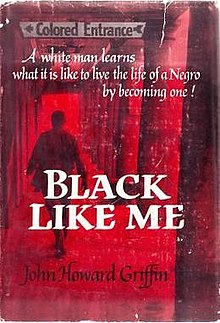Difference between revisions of "Black Like Me"
| (2 intermediate revisions by the same user not shown) | |||
| Line 1: | Line 1: | ||
[[File:Black like me.jpg|thumb|right|Book Cover]] | [[File:Black like me.jpg|thumb|right|Book Cover]] | ||
| − | Black Like Me | + | Black Like Me is a nonfiction book by a journalist John Howard Griffin. The book was first published in 1961. The book reveals a story of his journey in the Deep South of the United States, at a time when African-Americans lived under racial segregation. Griffin is a white man from Texas. He had his skin temporarily darkened by a dermatologist just so that he can experience a life as a black man. |
| − | In 1964, a | + | After having his skin darkened, he traveled for six weeks throughout the racially segregated states of Louisiana, Mississippi, Alabama, Arkansas, and Georgia. Griffin kept a diary of his encounters; the 188-page journal was the beginning of the book. When he started his project in 1959, race relations in America were particularly strained.The title of the book is taken from the last line of the Langston Hughes sonnet "Dream Variations" |
| + | |||
| + | In 1964, a movie version of the book was released. A generation later, Robert Bonazzi distributed a true to life book about Griffin, these occasions, and his life: Man in the Mirror: John Howard Griffin and the Story of Black Like Me (1997).<ref>https://en.wikipedia.org/wiki/Black_Like_Me</ref> | ||
==Black Empowerment== | ==Black Empowerment== | ||
| − | The book | + | The book assist people to understand more by closing the gap of racist segregation between black and white people after his book was distributed, Griffin got numerous letters of support. He said they helped him understand the experience while saying: "There were six thousand letters to date and only nine of them abusive."<ref>p. 184</ref> Nell Irvin Painter says: Fifty years after its distribution, Black Like Me stays a wonderful archive. John Howard Griffin changed more than the shade of his skin. He helped change the manner in which America saw itself. The book resonates even until recent era because it tells about humanity more than just a race.<ref>https://www.smithsonianmag.com/arts-culture/black-like-me-50-years-later-74543463/</ref> |
==Controversy== | ==Controversy== | ||
| − | In 1964, while stopped with a flat tire in Mississippi, Griffin was | + | In 1964, while stopped with a flat tire in Mississippi, Griffin was attached by a group of white men and beaten with chains, as a form of criticism towards his book. In a 1975 essay included in later editions of the book, he mentioned that he experience hatred and dangers to him and his family in his old neighborhood of Mansfield, Texas. He later moved to Mexico to keep himself safe.<ref>https://www.theguardian.com/books/2011/oct/27/black-like-me-john-howard-griffin</ref> |
==Reference== | ==Reference== | ||
| Line 15: | Line 17: | ||
==External Link== | ==External Link== | ||
| − | * https://www.washingtonpost.com/wp-dyn/content/article/2007/03/16/AR2007031602173.html | + | *https://www.washingtonpost.com/wp-dyn/content/article/2007/03/16/AR2007031602173.html |
| − | * https://www.westada.org/site/handlers/filedownload.ashx?moduleinstanceid=3789&dataid=100147&FileName=blacklikeme_TEXT.pdf | + | *https://www.westada.org/site/handlers/filedownload.ashx?moduleinstanceid=3789&dataid=100147&FileName=blacklikeme_TEXT.pdf |
| − | * https://www.washingtonpost.com/wp-dyn/content/article/2007/03/16/AR2007031602173.html | + | *https://www.washingtonpost.com/wp-dyn/content/article/2007/03/16/AR2007031602173.html |
| − | [[Category:Anti-Black Racism in | + | [[Category:Anti-Black Racism in Nonfiction Books]] |
| − | [[Category:Black Racism in | + | [[Category:Black-Targeted Racism in Nonfiction Books]] |
Latest revision as of 07:34, 15 March 2021
Black Like Me is a nonfiction book by a journalist John Howard Griffin. The book was first published in 1961. The book reveals a story of his journey in the Deep South of the United States, at a time when African-Americans lived under racial segregation. Griffin is a white man from Texas. He had his skin temporarily darkened by a dermatologist just so that he can experience a life as a black man.
After having his skin darkened, he traveled for six weeks throughout the racially segregated states of Louisiana, Mississippi, Alabama, Arkansas, and Georgia. Griffin kept a diary of his encounters; the 188-page journal was the beginning of the book. When he started his project in 1959, race relations in America were particularly strained.The title of the book is taken from the last line of the Langston Hughes sonnet "Dream Variations"
In 1964, a movie version of the book was released. A generation later, Robert Bonazzi distributed a true to life book about Griffin, these occasions, and his life: Man in the Mirror: John Howard Griffin and the Story of Black Like Me (1997).[1]
Black Empowerment
The book assist people to understand more by closing the gap of racist segregation between black and white people after his book was distributed, Griffin got numerous letters of support. He said they helped him understand the experience while saying: "There were six thousand letters to date and only nine of them abusive."[2] Nell Irvin Painter says: Fifty years after its distribution, Black Like Me stays a wonderful archive. John Howard Griffin changed more than the shade of his skin. He helped change the manner in which America saw itself. The book resonates even until recent era because it tells about humanity more than just a race.[3]
Controversy
In 1964, while stopped with a flat tire in Mississippi, Griffin was attached by a group of white men and beaten with chains, as a form of criticism towards his book. In a 1975 essay included in later editions of the book, he mentioned that he experience hatred and dangers to him and his family in his old neighborhood of Mansfield, Texas. He later moved to Mexico to keep himself safe.[4]
